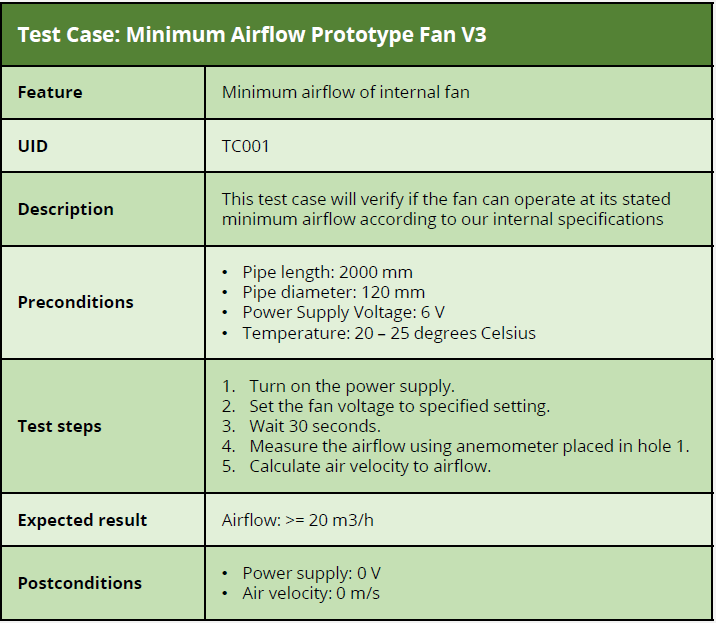How to Write Good Test Cases

Writing good test cases is crucial for ensuring quality and functionality when testing in a development phase, or a quality control test in an end-of-line test. A well-written test case helps in identifying defects or unmet objectives when performing tests.
In this guide, we will discuss some tips on how to create test cases that are clear, and useful, give you a test case template that we follow here at Encida, and give our opinion on best practices for writing test cases.
Test Case Example
Let us start with an example of how we would write a test case for testing the airflow of a fan. This would of course just be one of many test cases in our test scenario, but it shows our suggestion for a test case design.

The 7 Steps To Make a Great Test Case
Our test case example contains 7 definition steps in order to make it a great test case. These steps are crucial for ensuring that your test case is effective and delivers the intended results. Let's take a closer look at each step.
Feature
The feature is the feature you are trying to test. This should be clear and concise so that anyone reading the test case can easily understand what feature or function is being tested.
Unique Identifier
Each test case should have a unique identifier, a unique test case ID, such as a number or code. The test case ID makes it easier to track and reference when needed. A test case ID is typically identified with TC followed by a number, for example, TC01.
Description
The test case description should provide a clear and detailed explanation of what the test will cover. Here it is important to now write an entire novel but don't skip it because it is crucial for you down the line or for your colleagues.
Preconditions
Preconditions are any necessary steps or conditions that must be met before the test can be executed. This could include setting up specific equipment, a test environment or certain test scenarios that must be reached before we can actually conduct the test.
Test Steps
The test steps are the actual steps that will be executed to perform the test. These should be clear and easy to follow, including any inputs or expected outputs.
Expected Results
Expected results are what we expect to see as a result of executing the test steps correctly. This could include the successful completion of a function or specific output values.
Postconditions
Postconditions are the state that should be achieved after the test is completed. This could include a change in product status or any necessary cleanup steps.
Want To Get This Test Case Template?
If you're interested in adopting the test case template we use here at Encida, you're in luck. We're offering access to our template FOR FREE, which is designed to streamline the testing process and enhance clarity and efficiency.
To get your hands on this template, simply follow the link below. This template not only guides you through each step of creating a comprehensive test case but also ensures that nothing is overlooked.
Remember, a good test case is not just about following a template; it's about understanding the objective behind each test. By using our template in conjunction with the best practices outlined in this guide, you’ll be well-equipped to write test cases that significantly contribute to the quality and success of your projects.
Top 3 Common Mistakes to Avoid in Test Case Writing
While striving to craft comprehensive test cases, there are several common pitfalls that testers can encounter. Avoiding these mistakes is as crucial as following best practices. The top 3 mistakes we see are.

The Test Cases are Not Specific Enough
Vague or general test cases can not only lead to ambiguous results but can also cause confusion and delays in the testing process. It's important to be as specific and detailed as possible in your test case writing.
Here it is especially important to be very thoughtful and strict when it comes to the expected result. Sometimes when manual testing testing team can redo a test or think it is fine if the test data (actual results) are close to the limit.
Omitting Negative Scenarios
While positive scenarios are important to test, it's equally crucial to also include negative scenarios in your test cases. This helps uncover potential issues and flaws in the system that may not have been considered otherwise.
This is both applicable to performance testing and quality control. A good example for performance testing can be to not define a test case for a minimum and only define one for the average air flow if we take the example above.
Failure to Update Test Cases
As you get more data from your tests and feedback from customers it is important to update existing test cases, to improve test coverage, track progress, and stay aligned with project objectives.
Failure to update test cases can lead to outdated or irrelevant tests being performed, resulting in a waste of time and resources.
Conclusion
In conclusion, writing good test case is on the surface simple but actually writing high quality test cases and a great test suite can be very difficult and time-consuming. But having good test cases makes especially test documentation and test automation much simpler in our experience.
By following the steps outlined in this guide and using our test case template, you will not only save time but also ensure that your tests are effective and contribute to a successful project outcome.
Remember to always be specific, include negative scenarios, and regularly update your test cases for optimal results.
If you need help you can always book a time with one of our test experts, we love to help.